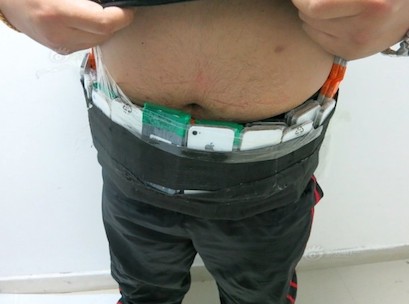Shenzhen-based technology writer Paul Bischoff has explained the background to why China’s government has changed the rules for mainland residents with multiple entry visas.
This week, China, acting on a request from Hong Kong, announced multiple entry visa holders could now only make a trip into Hong Kong just once a week in a bid to reduce increasing tensions between traders and shoppers in the New Territories bulk-buying goods in Hong Kong for resale in China at inflated prices.
Bischoff says the practice has become so widespread it has even earned its own colloquialism, goudai, which means to buy and bring back.
“The implications of that seemingly simple law are broad, and it will have a large impact on one product that matters to Tech in Asia readers: the iPhone,” he writes on TechInAsia.com.
The border between the mainland boomtown of Shenzhen and Hong Kong is the busiest land border crossing in the world with 47 million visits last year by Chinese mainlanders.
“Grey market importing from Hong Kong to Shenzhen has become an industry in itself, with hundreds and even thousands of these “visitors” from Shenzhen buying up stock in Hong Kong and trucking it back over the border on foot, every day. The reason? Taxes, mainly. Taxes and tariffs on imported items are much lower and in some cases nonexistent in Hong Kong. Among the most popular items are baby formula, luxury fashion items, and electronics – most notably, iPhones.
“Not only are iPhones cheaper in Hong Kong, the latest models are usually released there earlier than on the mainland. As a result, Apple stores in Hong Kong are often packed end-to-end with hours-long queues of people just waiting to get their hands on an iPhone only to scalp it minutes later to a smuggler standing outside the store for well above what they paid in-store. China’s demand for iPhones is so insatiable that this goes on well beyond even the China launch date for the newest iPhone, though prices are most inflated when new models hit the shelves.”
Bischoff says the business is so lucrative it’s more than worth taking the risk for many smugglers, leading to humorous but revealing situations like this one, where a man is caught with 146 iPhones taped to his torso. This was his fifth such offense.
“That man got caught, but keep in mind this is his day job. He and many others make their way through the border every day without being searched. Typically, only large bags go through a scanner, but small bags and anything kept on your body are usually not searched whatsoever, unless you’re walking funny due to the weight of 146 iPhones.”
Bischoff lives in Shenzhen and uses this border crossing often. “It’s common to see people getting their stuff confiscated at security, but it’s also plain to see that most people make it through without any interference at all. Sometimes there’s a metal detector to walk through, but the security staff never stop anyone to wand them or pat them down despite an alarm sounding on almost every single person who walks through it.”
He says Shenzhen residents have enjoyed more relaxed regulations for going in and out of Hong Kong than residents of other mainland cities. But with the new once-per-week limit in place, China’s grey market could take a huge hit.
“Hong Kong was lax before because it wanted to profit from well-off Shenzhen residents visiting the city and injecting some cash into the local economy. But the nature of visits has largely shifted from actual tourists to those in the goudai industry, who enter the city with a singular purpose and don’t contribute much beyond buying as many borderline-illegal goods as they can carry.”
He says the new rules could impact how Apple releases future iPhone models in China. In 2013, it launched sales of the iPhone 5S and 5C simultaneously in China, Hong Kong, and the US for the first time ever. But regulatory setbacks in the approval process for the iPhone 6 and 6 Plus set back the 2014 launch date by more than a month. As China waited for the iPhone to go on sale in their own country, the price of grey market imports skyrocketed to US$1600 on average for an iPhone 6, with some going for as much as US$5000.
“Apple loses money due to delayed rollouts in China, but the ability for mainlanders to buy via Hong Kong in the interim helps buffer some of the company’s losses. If smugglers are cut off from the source, the company will likely push even harder for simultaneous releases in the future. If not, expect the price of the next generation of China’s grey market iPhones to reach new heights.”
The irony of the whole situation, he observes, is that iPhones are manufactured in China.








